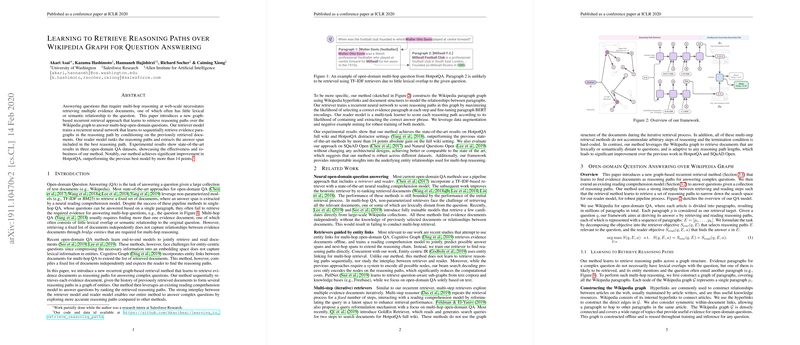Learning to Retrieve Reasoning Paths over Wikipedia Graph for Question Answering
The paper, "Learning to Retrieve Reasoning Paths over Wikipedia Graph for Question Answering," presents a novel approach to open-domain question answering (QA) that emphasizes multi-hop reasoning. This approach addresses the challenge of retrieving relevant evidence spanning multiple documents, which conventional single-hop QA systems struggle with, due to constraints on relational data retrieval between documents.
Methodological Advancements
The authors propose a method based on a graph-structured representation of Wikipedia, wherein nodes represent paragraphs and edges are either Wikipedia hyperlinks or within-document links. This graph formulation naturally supports multi-hop reasoning by facilitating path traversal between semantically related paragraphs.
- Recurrent Graph-Based Retriever: This component tackles multi-hop retrieval by leveraging a recurrent neural network (RNN) architecture. The RNN sequentially selects paragraphs, conditioned on previously retrieved ones, constructing reasoning paths across the graph. It initializes with a TF-IDF retrieved set of paragraphs from Wikipedia, significantly reducing the search space.
- Reader Model and Re-Ranking: To extract the final answer, a reading comprehension model is employed. This model re-ranks reasoning paths using contextual BERT embeddings, fine-tuned to capture relationships within the concatenated paragraphs of each path.
Experimental Insights
The approach was rigorously tested across three QA datasets: HotpotQA, SQuAD Open, and Natural Questions Open. The model achieved state-of-the-art results, notably in HotpotQA's full wiki setting, with impressive performance gains—particularly a more than 14-point improvement in F1 over previous models. The robustness of this method across datasets underscores its versatility in handling various open-domain QA challenges.
Practical and Theoretical Implications
The empirical results highlight several important aspects:
- Enhanced Reasoning Capabilities: By structuring Wikipedia as a graph and employing multi-hop retrieval, the method captures complex relationships between entities, reflecting a more human-like reasoning process. This aligns well with theoretical advances in representation learning that argue for contextual embeddings in multi-turn reasoning.
- Scalability and Efficiency: The initial use of TF-IDF to filter candidate paragraphs ensures scalability, an essential consideration for real-world applications dealing with vast information landscapes.
Future Directions
Considering the space of future developments, integrating end-to-end training for the graph-based retriever and reader could refine path selection and answer accuracy. Additionally, exploring graph structures beyond Wikipedia—extending to sources with heterogeneous link types—could further diversify the model's capabilities and resilience to varying data quality and structures.
In summary, this paper contributes a powerful method to the QA ecosystem, blending graph-based reasoning with deep learning to navigate complex informational terrain, fostering advancements in both model interpretability and performance.
